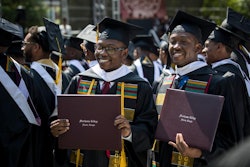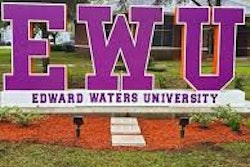Professor Suggests Survival of the Fittest Strategy For AME Colleges
Closing some campuses and reallocating funds to others could be best option for struggling institutions.
By Herb Frazier
CHARLESTON, S.C.
Like Morris Brown in Atlanta, a number of African Methodist Episcopal Church-sponsored colleges are in financial trouble. A College of Charleston history professor says AME could improve its colleges if it closed weak campuses and moved resources to stronger ones.
Dr. Bernard E. Powers Jr. says the church should recapture the post-Civil War vision of AME Bishop Daniel A. Payne, a founder of Wilberforce University in Ohio and its first Black president. It was Payne’s dream for the church to have a college to train ministers and newly freed slaves.
But as the need to educate preachers in the pulpit and church members in the pews expanded across the South, so did the number of AME campuses.
At one point in its history, the AME church supported 12 junior and four-year colleges and seminaries in 10 states. Today, the number of AME-affiliated campuses has been reduced to eight schools in six states, mostly in the South. All of them have struggled financially.
“The church needs to look at whether it has too many schools, and it may very well find that we have too many,” says Powers, who grew up attending St. James AME Church in Chicago. He is now a member of the steward board at Morris Brown AME Church in Charleston, Payne’s birthplace. “Some may need to be closed or consolidated with an eye toward strengthening those that remain.
“Leaders of the church think it is prestigious to have a college in their district, but we don’t just want to have a college,” he continues. “We want to have colleges that turn out quality students.”
AME Bishop Adam Jefferson Richardson Jr. says Powers’s idea “is not a new one in the least. It is something we have rehearsed again and again. But there are issues that have to be addressed when you talk about consolidation.”
Initially, AME schools were an outlet for oppressed Blacks, says Richardson, chairman of the church’s Commission on Seminary, Universities, Colleges and Schools and the presiding prelate of the Second Episcopal District in Washington, D.C. “The schools were our contribution to the liberation of Black people. We hired people, and we gave stature to the professors. The colleges were the economic engine for communities.”
The schools were originally founded by the annual conferences. But as they evolved, the school trustees gained stewardship of the campuses, holding them in trust for the annual conferences. The AME church contributes more than $4 million to the eight campuses, he says.
“At this point it would be difficult for the denomination to say ‘shutdown,’” Richardson says. “The only thing the denomination could say is that we would withdraw our support. But they are just not going to do that. Perhaps, we could better utilize our resources to help one or two institutions. But I don’t see that happening. The AME church, as a denomination, only votes to give schools money. It does not say we have the authority to close you. That is the function of the trustees of the institutions.”
Therefore, Richardson says, the question of who can shut down a campus is a legal issue. Only the trustees of each of the campuses can make that call, he says.
In recent years, the academic record of the eight campuses have given the church little to boast about. The campuses are open to anyone, regardless of religion or ethnicity, and all of them — including Wilberforce, the flagship institution — have experienced their share of problems. Morris Brown is the most recent example.
The college has lost its accreditation, and its former president, Dr. Dolores Cross, and financial aid director, Parvesh Singh, pleaded guilty to embezzlement earlier this year. They admitted in court to stealing federal funds to cover Morris Brown’s expenses.
“We are still raising money for Morris Brown,” Richardson says. “We are raising money with the hope of restoring it to some level of higher education.”
The Rev. Dr. Dennis C. Dickerson, professor of history at Vanderbilt University and the AME historiographer, says Blacks need more colleges and universities, not fewer. He points to Allen University in Columbia, S.C., as a positive example. Allen has more male students (311) than female students (219), the opposite of a current nationwide trend.
“They are doing something that Fisk [University] can’t do,” Dickerson says. “Would you want to close that down? These AME schools are positioned to do creative things, and unless you can demonstrate there is less of a need for higher education for Blacks, I don’t see where the argument comes from to close schools.”
Richardson agrees with Dickerson.
“I don’t believe we ought to be closing any more schools, if we can help it,” he says. “We have people in the denomination who are of a mind to get out of the education business because it is so costly, but I am glad they are few in number.”
Powers’s suggestion that the church shutter some of its campuses is an informal recommendation based on the research he is doing on Black Methodism in South Carolina.
His research, which he says is a church and community study, “will look at how the church is serving the church community and the geographic community.”
He says AME has no equivalent to prestigious historically Black colleges and universities like Howard University, Spelman College and Xavier University of Louisiana. “Why not? Maybe it is because the resources are spread too thin,” he says. “The AME Church is a strong church. It is a growing church, but that strength isn’t reflected in the health of the colleges and universities it supports, but it could be.”
Powers suggests that integration and a decline in Black philanthropy are among the root causes of the struggles AME institutions are currently facing. “And based on the people I know, AME people don’t think about sending their children to an AME school,” he says.
Richardson says comparing AME schools to Howard, Spelman and Xavier is unfair. “They have a presence that is based on location, performance and the attraction of major philanthropists to support those institutions,” he says.
The bishop says contributions to AME institutions have been cumulative over time, beginning with small donations from average people. But other factors have begun to steer students away. Richardson says that, as today’s parents give their children more latitude to decide where they want to study, college choices are becoming based more on economics and friendship and less on loyalty to the church and the Black community.
The AME-affiliated campuses in the United States, Liberia and South Africa
Four-year Colleges
• Allen University, Columbia, S.C.
• Edward Waters College, Jacksonville, Fla.
• Morris Brown College, Atlanta
• Paul Quinn College, Dallas
• Wilberforce University, Wilberforce, Ohio
• AME University, Monrovia, Liberia
Two-year Colleges
• Shorter College, Little Rock, Ark.
• Wilberforce Community College,
Evaton, South Africa
Graduate Seminaries
• Payne Theological Seminary,
Wilberforce, Ohio
• Turner Theological Seminary, Atlanta
© Copyright 2005 by DiverseEducation.com


















